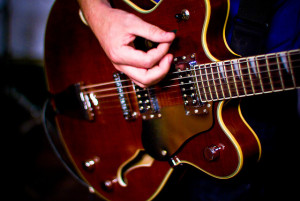What is copyright?
Because this blog will focus on the intersection between music and the law, including how that intersection affects music cities like Austin, Texas, where I live and practice law, occasionally it will feature a basic explanation of an area of the law to make that law more accessible to non-legal folks. A great place to start the basic law series (and the blog) is copyright law.
 Copyright law is, in a word, gooey. Some laws are relatively straightforward and easy to understand; a 65 mph speed limit, for example, clearly divides between legal activity (driving a car at or below 65 mph), and illegal activity (driving over 65 mph). Unfortunately, copyright law is not so straightforward because it deals with property, which is complex enough; add to that complexity that copyright deals with property of the mind, and it can be daunting. But even though it’s gooey, it’s not difficult to understand if you master a few basic concepts.
Copyright law is, in a word, gooey. Some laws are relatively straightforward and easy to understand; a 65 mph speed limit, for example, clearly divides between legal activity (driving a car at or below 65 mph), and illegal activity (driving over 65 mph). Unfortunately, copyright law is not so straightforward because it deals with property, which is complex enough; add to that complexity that copyright deals with property of the mind, and it can be daunting. But even though it’s gooey, it’s not difficult to understand if you master a few basic concepts.
Copyright Protects The Intangible
The first, and probably gooiest, thing about copyright is that it protects intangible property. Almost everything you can see or feel is tangible property: the computer, tablet, or cell phone you’re reading this on; the clothes you’re (probably) wearing; the house or apartment you live in; the car, bus, subway, or bicycle you use to get around. Generally, we think of property as things that we can see, touch, or hear. We think of property in that manner because it’s easy to conceptualize. What does it mean that this Martin acoustic guitar sitting next to me is my property? It means that I can do with it nearly anything that I please, including preventing anyone else from using or possessing it.
Copyright gets weird because it protects something that you can’t see, touch, or hear. Specifically, let’s talk about a “musical work” copyright, or the copyright that protects a song. A “musical work” copyright protects the expression of ideas that make up the song. That expression of ideas is made up of lots of elements that you already know, including the lyrics, the melody, the rhythm, the tempo, and the chord progressions.
So let’s say that I come up with an original song on my guitar. To remember the song, I use a piece of blank sheet music to notate the guitar notes, the vocal melody, and the lyrics. I also launch my computer’s recording software and record a demo of the song. Because it’s my creation, that “musical work” is mine; I created it, so I have the copyright to it. But that copyright doesn’t protect the sheet music that I used to write the song on, nor does it protect my recording of the song. My “musical work” copyright protects something that no one can see, touch, or hear: the expression of ideas as they are arranged in the song itself. The other things–the sheet music and the recording–are only tangible reductions of that expression.
“So where in the hell is your copyrighted song if it’s not written on the page or recorded in the computer?” you ask. That’s what I’m telling you. You can’t see it, touch it, or hear it. It’s everywhere and nowhere. In the ether. But it’s mine. And just like my guitar sitting next to me, I can do nearly anything that I want with the song. Copyright protects that expression.
(And just so that I don’t create any confusion, the demo that I recorded would qualify for a completely separate copyright under the category of “sound recording.” I’ll take on the topic of the different types of copyrights in a later post.)
Copyright Protects Original Works That Have Been Expressed In A Tangible Form
Once you wrap your head around the idea that copyright protects an expression, the elements of what can be protected aren’t that hard to grasp. The best place to start understanding those elements is in the United States Copyright Act, and specifically Chapter 17, Section 102 of the U.S. Code:
(a) Copyright protection subsists, in accordance with this title, in original works of authorship fixed in any tangible medium of expression, now known or later developed, from which they can be perceived, reproduced, or otherwise communicated, either directly or with the aid of a machine or device.
The first requirement is that the work be original. “Original” in the copyright sense asks whether the author created the work herself. So, quite simply, if I write a song, it meets the originality requirement. On the other hand, if I attempt to claim “Couldn’t Stand the Weather” as my own, it doesn’t pass the originality requirement because I didn’t create it; Stevie Ray Vaughan did. Finally, although there is a minor creativity element of the originality requirement, it’s an extremely low bar that songs will almost always pass.
The second requirement is that the work be an original expression of an idea rather than the idea itself. This is another spot where copyright can get a little gooey, but fortunately for us, the distinction in music is pretty straightforward. An idea itself can’t be copyrighted. So no one can copyright the idea of love, or copyright a song about love that excludes anyone else from ever writing a song about love. But an original expression about love can be copyrighted. So when Stevie Ray sings, “She’s my sweet little thing, she’s my pride and joy,” he’s taken the idea of love and created an original expression of that idea that is protected. The reason underlying the distinction between expression of ideas and ideas helps the rule make sense: we don’t want to prevent people from using ideas, but we do want to prevent people from copying original, unique expressions about those ideas.
The third and final requirement is that the work be fixed in tangible form. For musical works, that can be either sheet music or a recording. “But you said that those things weren’t copyrightable musical works!” you retort. You’re right; they’re not. But in order for an intangible song to be protected by copyright, there must be tangible proof that it was created. And that tangible proof comes in the form of sheet music or a recording. This factor is rooted in practicality: if there were no fixation requirement, then someone could simply say that they came up with a song the day before the original author did. With the fixation requirement, that’s no longer a problem.
Conclusion
I hope that this explanation provided a little clarity on the topic of copyright, and sparked some additional questions regarding copyright that I can answer in the future. Thanks for reading!
MM
